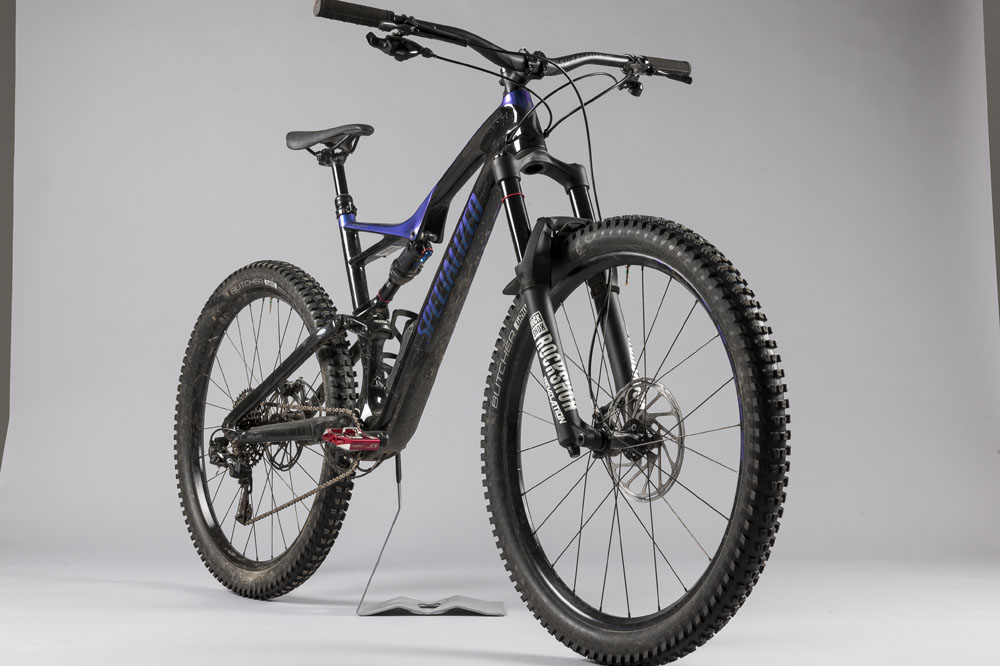Outgoing model that was way past its prime
Specialized Stumpjumper FSR Comp Carbon (2018) review
With the Specialized Stumpjumper FSR Comp Carbon the bike that started a revolution has been transformed into a modern trail heavyweight.
>>> Specialized Stumpjumper range explained
Last year we tested the specific Plus-tyre version of the Stumpjumper – called the 6Fattie. For 2018 this model only half exists, as it retains the name and the ability to run Plus, but actually comes with 29in wheels and 2.3in tyres. So, we’ve changed tactics, and used the 650b model for this test. Shod with 2.6in tyres means it meets our Plus bike criteria, but also makes the Stumpjumper Comp Carbon something of the black sheep in this category.

Specialized Stumpjumper FSR Comp Carbon review
At £3,500 it also undercuts the other bikes in this category by a hefty margin. However, with a streamlined range for this year, and the next model coming in at just under £5k, this is the closest price point to our nominal £4k budget.
As it’s the cheapest bike in this category, there are obvious sacrifices in the spec compared to the competition; the Comp Carbon makes do with a RockShox Revelation suspension fork and a 1×11 drivetrain with a narrower spread of gears.
One major selling point of the Stumpjumper over its competitors is the SWAT door in the down tube of the carbon front triangle. Unlocking the hatch takes seconds and gives you access to a massive compartment within the down tube that will happily swallow food, tools and even a jacket.
Suspension
The 650b Stumpjumper gets 150mm of rear wheel travel, which is as much as the Scott Genius 720 and makes it the joint longest travel bike in its class. But it also has the shortest stroke shock, and this means the damping circuit in the Monarch RT has to work much harder than the Fox shock on the Scott to control the same amount of travel. While this is only really an issue on long descents, the Specialized design does relinquish its travel more easily than the other bikes here and doesn’t hold your body weight up particularly well in compressions and bermed corners.
Having a unique anchor point to the stirrup-shaped shock yoke limits your options for upgrading the suspension, too, and while the Autosag system is designed to make set-up easier, on this bike we struggled to achieve the right balance using it. Instead we went old school and used a tape measure to dial in 12mm (20 per cent) of sag on the shock body, and this helped keep the bike from using up all its travel in the blink of an eye.
Because the RockShox Revelation shares a sturdy 35mm chassis with the Pike, it slipped under the radar during our initial inspection. But on the first ride it barely moved, even on big compressions, and we decided something had to be wrong. Sure enough we found out that undersized bushings were choking the fork’s abilities to move. Apparently only a small batch of forks are affected, and it’s an issue that’s covered by warranty, but it’s something worth checking if you have a Revelation. And with a replacement fork installed, the problem didn’t arise again.
Components
Specialized’s 2.6in Butcher tyres boast a similar tread pattern to the Maxxis Minion DHF and work extremely well in a wide variety of terrain and conditions. The new Gripton rubber compound sticks to wet roots with such conviction that we could really trust in the traction where the Rekon began to flounder. Put a Vernier caliper on the carcass and the width difference is only 4mm, but it’s a completely different ride experience. There’s a much more direct connection with the ground, and you can really load the tyre up in turns without any of that vague, squishy feeling that sometimes comes with a bigger volume option. So if you love the extra traction and comfort that comes from having more air beneath you, but hate feeling like there’s a delay between your inputs and the bike’s reaction, then 2.6in tyres are definitely for you.
Performance
Rewind twelve months and we gave the Stumpjumper 6Fattie a grilling for its diminutive sizing and disappointing suspension. A year has passed and none of our criticisms have been answered. In fact, by testing the Comp Carbon 650b, we’ve actually taken a step backwards, as the frame is even more compact. To put it into context, the size large Scott Genius shares a very similar seat tube measurement (within 5mm) to the Stumpjumper, but the reach is 30mm longer and the wheelbase is 70mm longer. Yes, these are just numbers on a chart, but the consequences overwhelm the ride experience on the trail and the result is a bike that feels unsettled at speed, frantic in the rough and out of its depth on challenging trails.
Verdict
Specialized’s motto is Innovate or Die, but this Stumpjumper should have been put out to pasture a long time ago. The geometry is outdated and easily overwhelmed on technical trails, while the suspension lacks the sensitivity and polish that we’re used to from Specialized. And to cap it all off, it’s not particularly competitive on price, either, so you are effectively paying a premium for less performance. Since we finished testing this model, Specialized has released its new Stumpjumper, and we’re pleased to report that it’s been subject to a comprehensive redesign rather than a token sticking plaster. The result is a bike that completely answers our criticisms. We haven’t tested it fully yet, but you can read our first impressions by clicking on the link above.
















